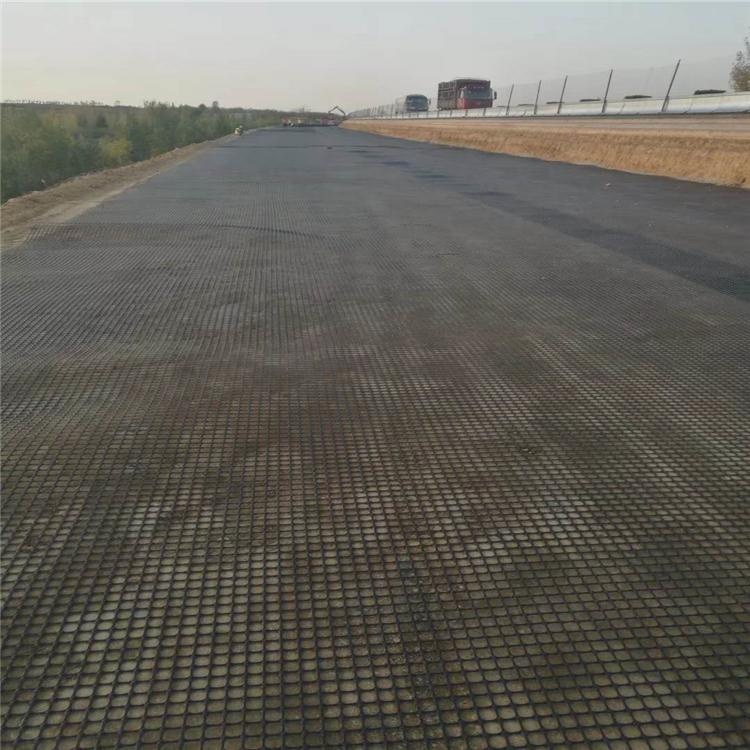Description

Process flow: check and clean up the lower bearing layer → manual layingGeogrid→ lapping, binding and fixing → paving the upper subgrade soil → rolling → inspection.
The geogrid is laid on the flat lower bearing layer according to the planned width, and the upper and lower layersfillerThere are no sundries stabbing the geogrid. When laying the geogrid, the direction with high strength shall be arranged perpendicular to the embankment axis. The geogrid is laid horizontally. When laying, tighten and straighten to prevent wrinkles, distortion or potholes. The geogrid shall be spliced along the longitudinal direction by overlapping method, and the overlapping width shall not be less than 20cm.
After the geogrid is paved, the upper filler shall be paved manually, and the rolling shall be completed in time to prevent long-term exposure. Then select mechanical transportation, leveling and rolling. Mechanical paving and rolling shall be carried out from both ends to the middle, and rolling shall be carried out from both ends to the middle, and its compactness shall meet the requirements of the specification.
It is forbidden for all construction vehicles and construction machinery to trek or park on the paved geogrid. The quality of geogrid shall be checked at any time during construction. If it is found that there is damage such as breakage, puncture and tear, it shall be repaired or replaced according to the degree.
1、Material Science:
(1)Geogrid
Geogrid is one of the latest geotechnical building materials in China. It has high tensile strength(>100KN/m,The elongation is less than 15%, the standard has good stability, corrosion resistance, anti-aging (the planned service life is 120 years, underground), wide temperature range (-50-120 ℃), and other characteristics. It has been widely used in dangerous slope protection, soft foundation treatment, reinforced soil retaining wall engineering and some structures with high bearing capacity. It is a new material with epoch-making significance in the construction industry. Geogrid is used for subgrade reinforcement and protection. The integration of grid and pavement materials can effectively distribute the load, prevent ballast loss and subgrade deformation, improve the stability of the forward subgrade and bear greater variable load.
(2)The sand cushion shall be medium (coarse) sand, and the mud content and other impurities shall be less than 5%.
2、Mechanics:
A 25t flat plate vibratory roller and a 50t flat plate towed vibratory roller, a 140 bulldozer and 7-8 workers are selected for construction.
3、Construction method
(1)Firstly, the subgrade slope line shall be set out accurately. In order to ensure the subgrade width, each side shall be widened by 0.5m. After leveling the exposed base soil, use 25t vibratory roller for static pressure twice, and then 50t vibratory roller for four times. The uneven foundation shall be leveled by local manual cooperation.
(2)0.3m thick medium (coarse) sand shall be paved. After manual and mechanical leveling, the 25t vibratory roller shall be statically pressed twice.
(3)Lay geogrid. When the geogrid is laid, the bottom surface shall be flat and dense. Generally, it shall be laid flat, straightened and shall not be stacked. It shall not be tortuous or kinked. The two adjacent geogrids shall be overlapped for 0.2m, and the geogrid shall be overlapped along the transverse direction of the subgrade. Some geogrids shall be connected with No. 8 iron wire every 1m, and fixed on the ground with U-nails every 1.5-2m.
(4)After the first layer of geogrid is paved, the second layer of 0.2m thick medium (coarse) sand is initially filled. The method is: the sand is transported by car to the construction site and unloaded on one side of the subgrade, and then pushed forward by bulldozer. First fill 0.1M within 2m at both ends of the subgrade, then fold up the first layer of geogrid, and then fill 0.1M thick medium (coarse) sand to prevent filling and pushing towards the middle at both ends, Stop all kinds of machinery from passing on the geogrid without filling medium (coarse) sand, so as to ensure that the geogrid is flat, free from bulge and wrinkle. After the second layer of medium (coarse) sand is leveled, horizontal measurement shall be carried out to prevent uneven filling thickness. After leveling, static pressure shall be carried out twice with 25t vibratory roller.
(5)The construction method of the second layer of geogrid is the same as that of the first layer. After that, fill 0.3m medium (coarse) sand. The filling method is the same as that of the first layer. After static pressing twice with 25t roller, the reinforcement of subgrade base will be completed.
(6)After the third layer of medium (coarse) sand is rolled, two geogrids are laid at both ends of the slope along the longitudinal direction of the line, overlapping 0.16m, and connected in the same way, and then the preliminary earthwork construction is carried out. The geogrid shall be laid for slope protection. It is necessary to measure the laid sideline of each layer, and each side shall ensure that the geogrid is buried 0.10m in the slope after slope renovation.
(7)When the slope geogrid is filled with two layers of soil, that is, when the thickness is 0.8m, a layer of geogrid shall be laid at both ends together, and so on until it is laid under the surface soil of the shoulder.
(8)After the subgrade is filled, the slope shall be repaired in time, and the dry rubble protection at the slope toe shall be carried out. In addition to widening 0.3m on each side of the subgrade, 1.5% settlement shall be reserved.